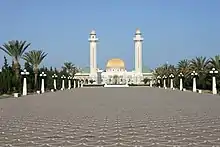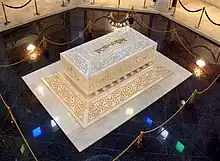ضريح بورقيبة | |
 General view of the Bourguiba mausoleum | |
| 35°46′39.9″N 10°49′42.47″E / 35.777750°N 10.8284639°E | |
| Location | Monastir, Tunisia |
|---|---|
| Designer | Olivier-Clément Cacoub |
| Type | Mausoleum |
| Beginning date | 1963 |
| Opening date | 1978 |
| Dedicated to | Habib Bourguiba |
The Bourguiba mausoleum is a monumental grave in Monastir, Tunisia, containing the remains of former president Habib Bourguiba, the father of Tunisian independence, who died on April 6, 2000.[1]
Description

The mausoleum was built while Bourguiba was still alive, in 1963, in the modern Arab-Muslim style. It is located in the western part of the Sidi El Mézeri cemetery, the main burial site in the city, at the end of the main alley which is about 200 m (660 ft) long and 30 m (98 ft) wide. The building is flanked by two 25-metre-high (82 ft) minarets and topped by a golden dome between two green domes. The mausoleum entrance gate and the gate that separates it from the rest of the cemetery are examples of Tunisian art.
In addition to the former president and his first wife, Mathilde, the mausoleum houses the bodies of his parents, his siblings, and other members of his family in two other halls. It was expanded in 1978.
Inside the mausoleum, there is a small museum housing some of president Bourguiba's personal belongings: his desk from the presidential palace of Carthage, his pens, passports and identity card, his glasses, and also his photos and his clothes (both Western and traditional: jebba, chéchia, and fez).[2]
Gallery
 Central part of the mausoleum topped by a large golden dome
Central part of the mausoleum topped by a large golden dome Main door of the mausoleum, made out of teak, with inscriptions in Arabic saying "the supreme fighter, builder of modern Tunisia, liberator of women
Main door of the mausoleum, made out of teak, with inscriptions in Arabic saying "the supreme fighter, builder of modern Tunisia, liberator of women One of the galleries of the mausoleum, the arcs sitting atop white marble columns
One of the galleries of the mausoleum, the arcs sitting atop white marble columns Domes of the mausoleum
Domes of the mausoleum Tomb of Bourguiba
Tomb of Bourguiba
See also
References
- ↑ Camau, M.; Geisser, V. (2004). Habib Bourguiba: la trace et l'héritage. Karthala. p. 391. ISBN 9782845865068. Retrieved 2016-08-18.
- ↑ Carlier, O.; Nollez-Goldbach, R. (2008). Le corps du leader: construction et représentation dans les pays du Sud. Harmattan. p. 117. ISBN 9782296061576. Retrieved 2016-08-18.